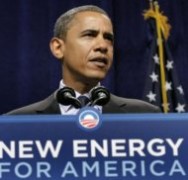
He can, but will he? “The world has changed; America must change with it,” says the new President. But will the new administration change its existing environmental pledges, or stick to their promised policies?
The stated policy is as follows.
? Help create 5 million new jobs by investing $150 billion over 10 years in clean energy initiatives
? Increase the nation’s use of electricity from renewable sources to 10 percent of our total use by 2012, and 25 percent by 2025
? Institute a national cap-and-trade program to reduce greenhouse gas emissions 80 percent by 2050.
The ambitious agenda might have been front and center during the transition period had it not been overshadowed by the imploding economy. Now Mr. Obama’s first priority will be to secure passage of an $800 billion stimulus package.
But the energy sector is a significant piece of that package. In an appearance at a wind-energy plant in suburban Cleveland last Friday, Mr. Obama touted the benefits of “a renewable energy economy,” including its potential to create jobs. The administration estimates that of the 4 million jobs that the stimulus package will create or save by the end of 2010, more than 450,000 will be energy- related.
But first, the plan must make it through Congress.
Bruce Bullock, director of the Maguire Energy Institute at Southern Methodist University’s Cox School of Business in Dallas, is skeptical about the passage of those parts of the plan that push alternative energy in light of the “food vs. fuel” controversy that emerged with the growth of corn-based ethanol.
“I don’t believe Congress or the American taxpayer is eager to subsidize another industry that will take even more money out of the consumers pocket,” he said. “Oil and natural gas are cheap now and the economics of alternative energy sources are questionable at best.”
Marilyn Ann Brown, professor of energy policy at the Georgia Institute of Technology in Atlanta, agrees that when it comes to alternative energy, “the Obama platform is possibly more aggressive than he can get into an energy bill.” Noting that about 3 percent or 4 percent of the nation’s electricity now comes from nonfossil-fuel sources, she said getting to 10 percent by 2012 “would be a heavy lift.”
“Twenty-five percent by 2025 may be more doable, because it’s so far out that people won’t be as cautionary,” she said.
Both experts agreed that initiatives to push energy efficiency would probably encounter smoother sailing in Congress.
Mr. Bullock sees the administration’s Smart Grid initiative, which calls for the creation of a Grid Modernization Commission, as a winner. The commission would be charged with facilitating the nationwide adoption of distributed generation, smart meters and other technologies to improve the efficiency and reliability of the electricity grid.
“Energy efficiency investments are the ‘low-hanging fruit’ and will likely pass with relative ease,” he said.
The plan calls for the development and deployment of “clean coal technology” that enables coal producers to capture the carbon dioxide emitted by coal and sequester it, or store it underground. Mr. Obama wants the Department of Energy to partner with private companies to develop five coal-fired electric plants that use carbon capture and sequestration.
Doing so “will help the industry to turn the corner” in the development of clean-coal facilities, said Thomas Hoffman, vice present of Consol Energy.
“Like most new technologies, there’s a long line of people who are ready to build the third plant that deploys it,” he said. “The challenge is to find people to do plant No. 1 and No. 2.”
One of the most ambitious elements of the Obama-Biden plan is the establishment of a national system for creating and trading carbon allowances, with the goal of reducing greenhouse gas emissions 80 percent by 2050.
Ms. Brown said that while there would be “major energy legislation” passed in 2009, a cap-and-trade regime would not be a part of it — first, because of uncertainty about associated costs, but also because there is still a “fundamental debate about whether it should be a cap-and-trade or a carbon tax,” with the Congressional Budget Office having gone on record as saying that the latter would be preferable.
The Obama-Biden plan also pledges to “reduce oil consumption enough within 10 years to save more oil than we currently import from the Middle East and Venezuela combined,” by increasing fuel economy standards and pushing for the development of hybrids and automotive battery technology.
The administration wants to see 1 million plug-in hybrid cars on the road by 2015, and has promised to take the lead by converting the entire White House fleet to plug-ins “as security permits” within one year. By 2012, half of all cars purchased by the federal government will be plug-in hybrids or all-electric cars.
The plan also mandates that by 2012 all new vehicles are flexible- fuel vehicles, able to run on biofuels as well as on gasoline.

One Response
I don’t see how Obama’s plan benefits off-grid’ers at all. Can someone shed some light here?